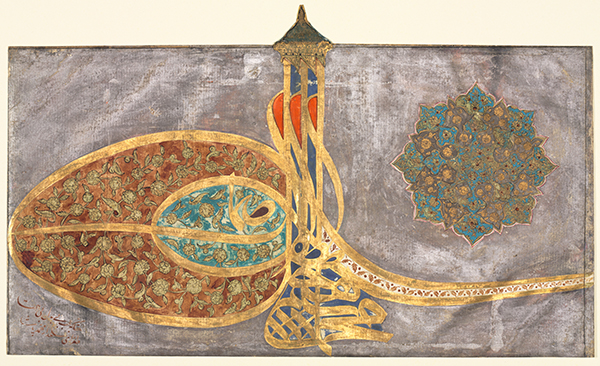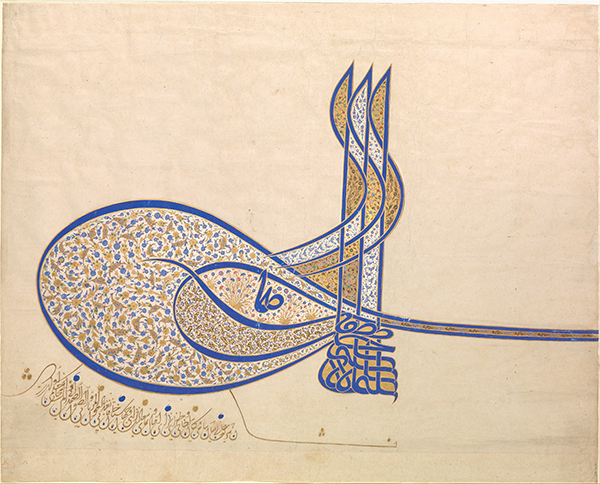Wistful about Writing: Tughra
I am painfully aware that very few people learn to write in cursive these days. When I was a teaching assistant in grad school, some students couldn’t read my grading remarks because I wrote them in cursive! While I mourn the slow fading of cursive writing, penmanship, and beautiful lettering by everyday people, I am comforted by the fact that there are lots of examples of beautiful, artistically manipulated works of lettering, writing, and calligraphy in museums! Perhaps the most complex manipulation of lettering is seen in the Ottoman Turk tughra. They’re also beautiful examples of line with personality.
 |
| Turkey, Tughra: Shah Muhammad bin Ibrahim Khan, al-muzaffar daima, Single Page Manuscript, 1648–1687. Opaque watercolor, and gold and silver leaf on paper, 9 5/8" x 18" (24.5 x 45.6 cm). The Cleveland Museum of Art, purchase from the J. H. Wade Fund, 1944.525. (8S-30385) |
The tughra was an imperial signature/calligraphic insignia/brand designed for Ottoman Empire (1299–1922) sultans and high officials. They were used on official documents, coins, and other objects that needed an official mark. The word tughra comes from the word for “seal” in Oghuz, a historical Turkish language.
This tughra has been cut off from a vertical scroll on which a proclamation of the Ottoman Sultan Mehmed IV (1642–1693, ruled 1648–1687) was written. Mehmed IV ruled during a time when the empire began to decline in power due to internal rivalries and the catastrophic military defeat at the Battle of Vienna in 1683.
In bold gold lettering, “Mehmed, son of Ibrahim Khan, the Eternally Victorious” is calligraphed in Turkish. These words form the structure of the design, which has been filled with colors, floral patterns, and topped with an architectural crown. A foliated sunburst in turquoise, gold, and silver augments the luxury of the monogram.
Islamic arts and culture flourished between the 600s CE and 1600s, a period that saw the collapse of the Roman and Byzantine Empires (ca. 476 CE and 1453, respectively), and the rise of western European nation-states. By the 900s, many regional Muslim powers had developed their own distinct artistic traditions, which differed from those in the West.
The importance of writing, which is emphasized throughout the Islamic Qur'an, led to the prominence of calligraphy as an art form. Islamic book arts, calligraphy, illustration, and binding, matured between 750 and 1258. Illustrated books with elaborate calligraphy became a major form of artistic expression. Calligraphers and illuminators were highly respected; their workshops were often sponsored by princes or courts.
The Ottoman Empire was a vast Turkish sultanate that covered Turkey, northeast Africa, southwest Asia, and southeast Europe. It was founded in the 1200s by Ottoman Turks and spread rapidly in the 1400s, taking over the areas once controlled by the Byzantine Empire (including Greece and Egypt), Arabia, and Syria. Mehmed I (died 1421) restored unity to the Ottoman Empire after the civil war that lasted from 1402 to 1413.
This tughra is a famous example from the Metropolitan Museum of Art, New York:
 |
| Turkey, Tughra (Insignia) of Sultan Süleiman the Magnificent, ca. 1550–1560. Ink, watercolor, and gold leaf on paper, 20 ½" x 25 5/8" (52.1 x 65.1 cm). The Metropolitan Museum of Art, New York, Rogers Fund, 1938. (8S-30331) |
A myth about the origin of the tughra implies that an illiterate early sultan dipped three fingers in ink and pressed them onto paper to make his official “signature.” In the refined form of the Tughra of Sultan Süleiman the Magnificent, there are three prominent vertical lines in the design. This part of the tughra design became standard during the reign of Sultan Mehmed (“the Conqueror”, 1432–1481).
All Ottoman tughras contain three vertical lines and two concentric ovals loops. The insignia is a form of artistic calligraphy that includes the name of the ruling sultan, the name of his father, and the phrase “eternally victorious.” Although tughras all appear to be the same, they required slight changes in the design and were made anew by court calligraphy artists.
The form of the tughra was simply meant to be recognized as the official “stamp” of the ruler, rather than to be read as calligraphy, which is difficult. It was even more difficult to reproduce the tughra because of the complexity of the design. The practice fell out of use in the early 1900s, toward the end of the Ottoman Empire.
Correlations to Davis programs: A Personal Journey 2E: 4.2; Explorations in Art 2E: Grade 5 5.2, 5.6; Explorations in Art 2E: Grade 6 5.5; Exploring Visual Design 4E: Unit 1; The Visual Experience 4E: 4.1


Comments